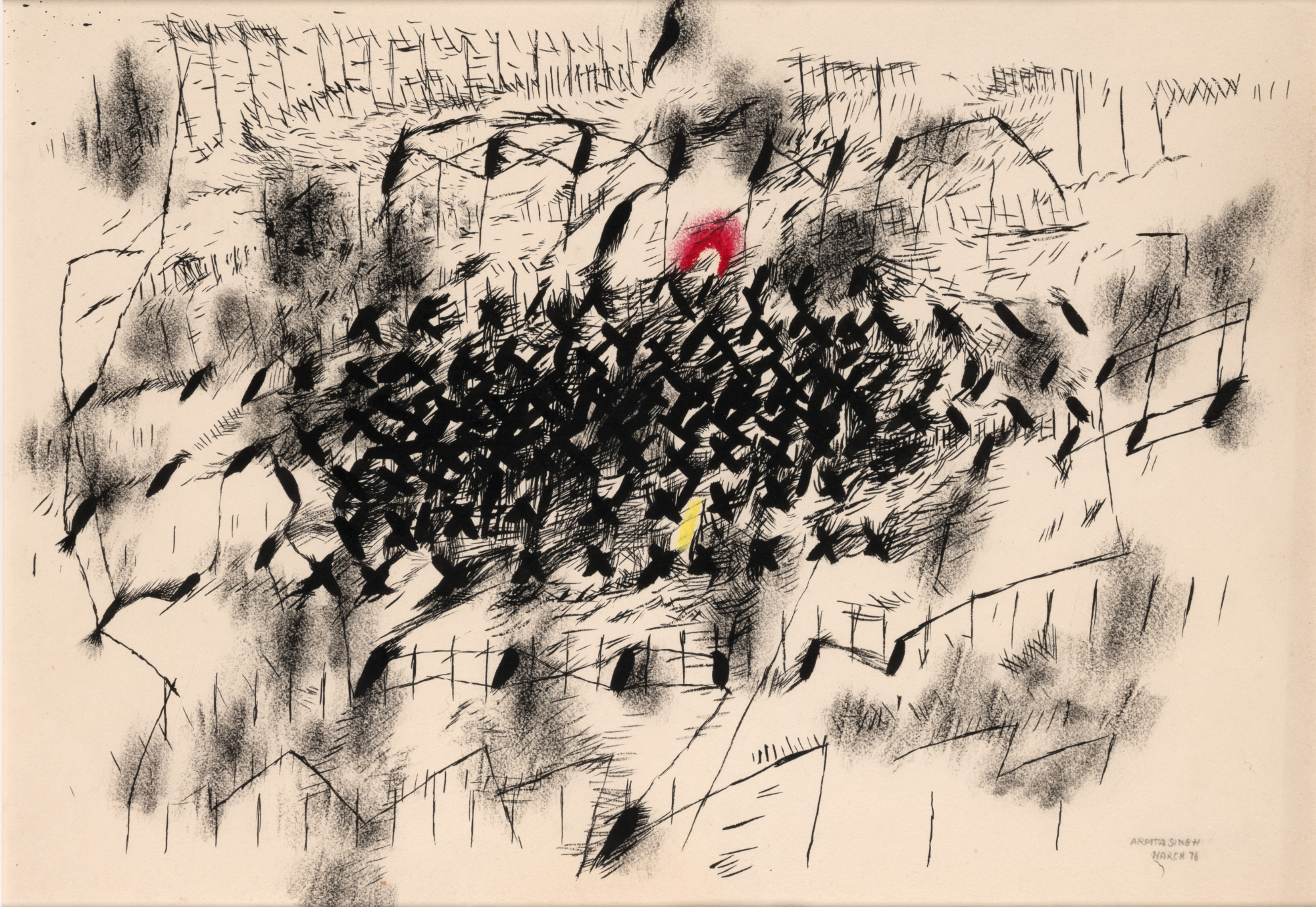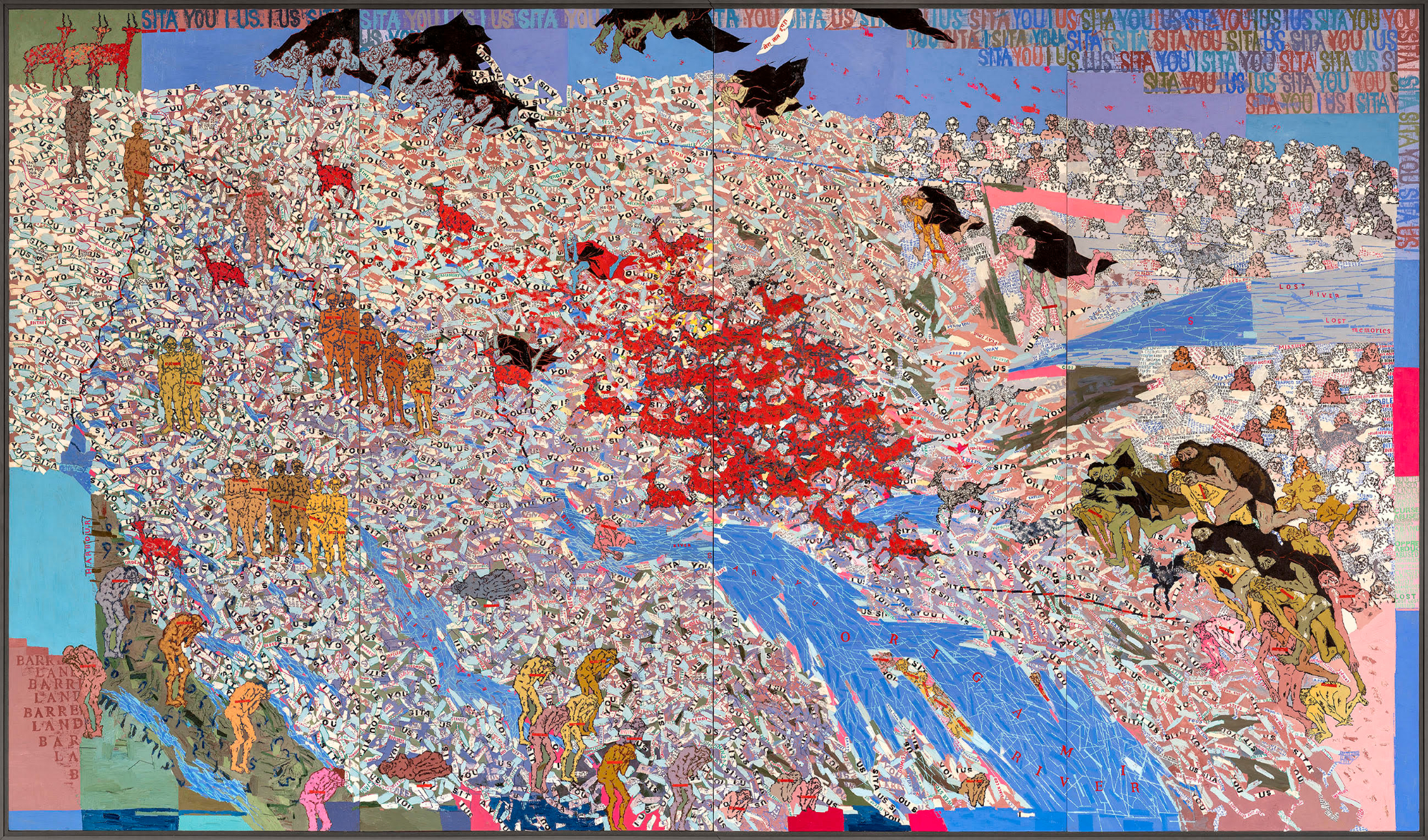アルピタ・シン
Arpita Singh

無題
1976年
ミクスト・メディア、紙
35×50 cm
所蔵:グレンバラ美術館(兵庫)
Untitled
1976
Mixed media on paper
35 x 50 cm
Collection: Glenbarra Art Museum, Hyogo, Japan
無題
1976年
ミクスト・メディア、紙
35×50 cm
所蔵:グレンバラ美術館(兵庫)
シンは、1960年代にはシュールレアリズムの影響がみられる風景画を制作していましたが、1970年代中頃から《無題》(1976年)のような抽象表現を始めました。細密な描写やパターンの反復からは、織物工房で働いていた時に習得したインドの伝統的な刺し子であるカンタ刺繍の技術の影響もうかがえます。
Untitled
1976
Mixed media on paper
35 x 50 cm
Collection: Glenbarra Art Museum, Hyogo, Japan
In the 1960s, Singh produced landscape paintings that showed the influence of surrealism, but starting in the mid-1970s, she turned towards a more abstract form of expression as seen in this work. Her detailed depictions and repetitive use of pattern show the influence of Kantha, traditional Indian embroidery technique that she learned while working in a textile workshop.

私のロリポップ・シティ:双子の出現
2005年
油彩、キャンバス
152.4×213.3 cm
所蔵:バデラ・アート・ギャラリー(ニューデリー)
My Lollipop City: Gemini Rising
2005
Oil on canvas
152.4 x 213.3 cm
Collection: Vadehra Art Gallery, New Delhi
私のロリポップ・シティ:双子の出現
2005年
油彩、キャンバス
152.4×213.3 cm
所蔵:バデラ・アート・ギャラリー(ニューデリー)
本作には、神話や歴史上の人物、銃、自動車、飛行機、動植物などのモチーフ、広告看板やテレビ、新聞などから引用されたイメージが断片的に描かれています。象徴的に描かれた双子を中心に飛行機などが上空に浮かび、デリーの地図の上には政治家のような男性達がいます。周囲に書かれた文字の中に「56人の男性と12人の女性(残りは失敗し、焼かれ、消された) 」とあり、よく見ると男性達に混じって半分地面に埋まっている17人の女性が描かれています。さらに「この地図は間違い 従うな 」とあり、本作が首都デリーを支配する権力構造やヒエラルキーへの批判であることがわかります。
My Lollipop City: Gemini Rising
2005
Oil on canvas
152.4 x 213.3 cm
Collection: Vadehra Art Gallery, New Delhi
This work contains fragments of images taken from mythological and historical figures, motifs such as guns, automobiles, airplanes, flora and fauna, advertising billboards, television, and newspapers. Airplanes and other objects float in the sky around a symbolically depicted pair of twins, while men that look like politicians are depicted on a map of Delhi. The text in the periphery reads, “56 men and 12 women (rest aborted, burnt, and banished),” and upon closer inspection, seventeen women are seen half buried in the ground among the crowds of men. It also says, “THIS MAP IS FAULTY DO NOT FOLLOW IT,” indicating that this work is a criticism of the power structure and hierarchy that dominates the capital city of Delhi.

破れた紙、紙片、ラベルの中でシータを探す
2015年
油彩、キャンバス
213.3×289.5 cm
所蔵:キラン・ナダール美術館(ニューデリー)
Searching Sita through Torn Papers, Paper Strips and Labels
2015
Oil on canvas
213.3 x 289.5 cm
Collection: Kiran Nadar Museum of Art, New Delhi
破れた紙、紙片、ラベルの中でシータを探す
2015年
油彩、キャンバス
213.3×289.5 cm
所蔵:キラン・ナダール美術館(ニューデリー)
何者かに襲われる女性たちが描かれた画面の上部には「シータ あなた 私 私たち 」とあります。シータはインドの叙事詩『ラーマーヤナ』のヒロイン(ラーマ王子の妻)のことです。本作は若い女性たちが被害者になる誘拐、性的暴行事件が後を絶たないインドの現状への応答でもあります。また、紙を繋ぎ合わせて描かれた川には「ORIGAMI」という文字が浮かんでいますが、これは平和を祈るための日本の千羽鶴に着想を得ています。
Searching Sita through Torn Papers, Paper Strips and Labels
2015
Oil on canvas
213.3 x 289.5 cm
Collection: Kiran Nadar Museum of Art, New Delhi
At the top of this painting, which depicts women being attacked by someone, is the phrase “Sita You I US.” Sita is the heroine (the wife of Prince Rama) of the Indian epic Ramayana. This work is a response to the current situation in India, where there are countless incidents of young women being kidnapped and sexually assaulted. Furthermore, as inspired by the Japanese thousand paper cranes as a prayer for peace, the word “ORIGAMI” can be seen on the river that has been created through connecting strips of paper.
アーティスト一覧ARTISTS
- Etel Adnan|エテル・アドナン
- Phyllida Barlow|フィリダ・バーロウ
- Anna Boghiguian|アンナ・ボギギアン
- Miriam Cahn|ミリアム・カーン
- Lili Dujourie|リリ・デュジュリー
- Anna Bella Geiger|アンナ・ベラ・ガイゲル
- Beatriz González|ベアトリス・ゴンザレス
- Carmen Herrera|カルメン・ヘレラ
- Kim Soun-Gui|キム・スンギ
- Suzanne Lacy|スザンヌ・レイシー
- Mishima Kimiyo|三島喜美代
- Miyamoto Kazuko|宮本和子
- Senga Nengudi|センガ・ネングディ
- Nunung WS|ヌヌンWS
- Arpita Singh|アルピタ・シン
- Robin White|ロビン・ホワイト

